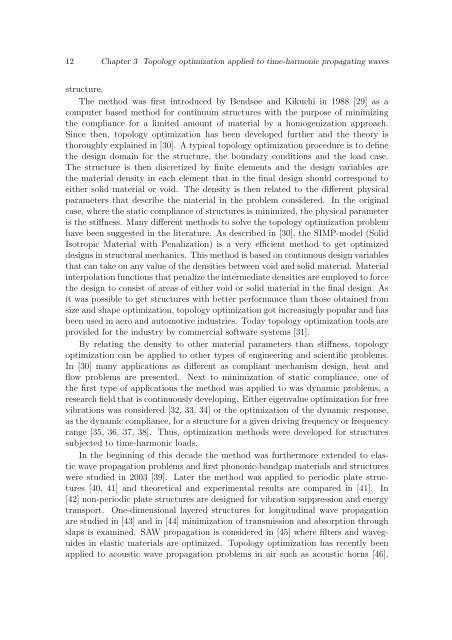Maria Bayard Dühring - Solid Mechanics
Maria Bayard Dühring - Solid Mechanics
Maria Bayard Dühring - Solid Mechanics
Create successful ePaper yourself
Turn your PDF publications into a flip-book with our unique Google optimized e-Paper software.
12 Chapter 3 Topology optimization applied to time-harmonic propagating waves<br />
structure.<br />
The method was first introduced by Bendsøe and Kikuchi in 1988 [29] as a<br />
computer based method for continuum structures with the purpose of minimizing<br />
the compliance for a limited amount of material by a homogenization approach.<br />
Since then, topology optimization has been developed further and the theory is<br />
thoroughly explained in [30]. A typical topology optimization procedure is to define<br />
the design domain for the structure, the boundary conditions and the load case.<br />
The structure is then discretized by finite elements and the design variables are<br />
the material density in each element that in the final design should correspond to<br />
either solid material or void. The density is then related to the different physical<br />
parameters that describe the material in the problem considered. In the original<br />
case, where the static compliance of structures is minimized, the physical parameter<br />
is the stiffness. Many different methods to solve the topology optimization problem<br />
have been suggested in the literature. As described in [30], the SIMP-model (<strong>Solid</strong><br />
Isotropic Material with Penalization) is a very efficient method to get optimized<br />
designs in structural mechanics. This method is based on continuous design variables<br />
that can take on any value of the densities between void and solid material. Material<br />
interpolation functions that penalize the intermediate densities are employed to force<br />
the design to consist of areas of either void or solid material in the final design. As<br />
it was possible to get structures with better performance than those obtained from<br />
size and shape optimization, topology optimization got increasingly popular and has<br />
been used in aero and automotive industries. Today topology optimization tools are<br />
provided for the industry by commercial software systems [31].<br />
By relating the density to other material parameters than stiffness, topology<br />
optimization can be applied to other types of engineering and scientific problems.<br />
In [30] many applications as different as compliant mechanism design, heat and<br />
flow problems are presented. Next to minimization of static compliance, one of<br />
the first type of applications the method was applied to was dynamic problems, a<br />
research field that is continuously developing. Either eigenvalue optimization for free<br />
vibrations was considered [32, 33, 34] or the optimization of the dynamic response,<br />
as the dynamic compliance, for a structure for a given driving frequency or frequency<br />
range [35, 36, 37, 38]. Thus, optimization methods were developed for structures<br />
subjected to time-harmonic loads.<br />
In the beginning of this decade the method was furthermore extended to elastic<br />
wave propagation problems and first phononic-bandgap materials and structures<br />
were studied in 2003 [39]. Later the method was applied to periodic plate structures<br />
[40, 41] and theoretical and experimental results are compared in [41]. In<br />
[42] non-periodic plate structures are designed for vibration suppression and energy<br />
transport. One-dimensional layered structures for longitudinal wave propagation<br />
are studied in [43] and in [44] minimization of transmission and absorption through<br />
slaps is examined. SAW propagation is considered in [45] where filters and waveguides<br />
in elastic materials are optimized. Topology optimization has recently been<br />
applied to acoustic wave propagation problems in air such as acoustic horns [46],
















